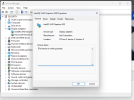Vettester
Known around here
- Feb 5, 2017
- 1,006
- 984
Awesome!I should have it ready by the end of week.
Also got the same result now after reinstalling/removing files everything including code project ai (its necessary in my case since I got an error with permission modifying files). Thanks for the help.I ran a test with you image and the only misread I am getting is the I is being read as as a 1. Can you post the module Info
View attachment 229788
View attachment 229787
View attachment 229784
Sample Image from Google
View attachment 229785
Result
View attachment 229783
I've had it going for about 24 hours and it is working great. I think it is more accurate. It is also picking up everything on a vehicle such as phone numbers, advertising ect... But, that is good!!I see 7 people downloaded the appsettings.json file, I am curious on how the new module is working for everyone.
It’s working much better than the old module. As previously mentioned it requires much less CPU processing and as an added bonus it seems to have resolved the memory leakage I was experiencing.I am curious on how the new module is working for everyone.
The AI model load is now on your iGPUIt’s working much better than the old module. As previously mentioned it requires much less CPU processing and as an added bonus it seems to have resolved the memory leakage I was experiencing.
HTTP Request → ALPRAdapter.process() → Image extraction → RGB to BGR conversionImage → PlateDetector.detect() → Day/Night plate bounding boxesPlate corners → four_point_transform() → Cropped & warped plate imagePlate image → StateClassifier.classify() → US state labelPlate image → CharacterDetector.detect() → Character bounding boxesCharacter crops → CharClassifierManager.classify_characters() → Character labelsCharacter detections → CharacterOrganizer.organize() → Sorted character sequenceSorted characters → Concatenate → Final license plate stringOriginal image → VehicleDetector.detect_and_classify() → Vehicle make/modelAll results → Format API response → Return JSONHTTP Request
↓
[ALPRAdapter] → Thread-safe processing
↓
[ALPRSystem] → Orchestration
↓
[PlateDetector] → Detect plates (day/night)
↓
[four_point_transform] → Extract plate region
↓
[StateClassifier] → Identify state (day plates only)
↓
[CharacterDetector] → Detect characters
↓
[CharClassifierManager] → Recognize characters
↓
[CharacterOrganizer] → Sort spatially (NOT by detection order)
↓
[Assembly] → Build license plate string + alternatives
↓
[VehicleDetector] → Detect & classify vehicle (optional)
↓
[Response] → JSON with all results
↓
HTTP Response| Model | File | Purpose |
|---|---|---|
| Plate Detector | plate_detector.onnx | Detects license plates (day/night) |
| State Classifier | state_classifier.onnx | Identifies US state from plate design |
| Character Detector | char_detector.onnx | Detects individual character locations |
| Character Classifier | char_classifier.onnx | Recognizes characters (OCR) |
| Vehicle Detector | vehicle_detector.onnx | Detects vehicles (optional) |
| Vehicle Classifier | vehicle_classifier.onnx | Classifies vehicle make/model (optional) |
POST /v1/vision/alpr{
"success": true,
"processMs": 150,
"inferenceMs": 120,
"count": 1,
"message": "Found 1 license plates: ABC1234",
"predictions": [
{
"confidence": 0.85,
"is_day_plate": true,
"label": "ABC1234",
"plate": "ABC1234",
"x_min": 100,
"y_min": 150,
"x_max": 300,
"y_max": 200,
"state": "CA",
"state_confidence": 0.92,
"top_plates": [
{"plate": "ABC1234", "confidence": 0.85},
{"plate": "ABC1Z34", "confidence": 0.78}
]
}
]
}I downloaded the appsettings.json file and followed your instructions, but the new module will not stay running on my machine. I will get more details on the exact symptoms and errors this evening. I am away from the PC right now.I see 7 people downloaded the appsettings.json file, I am curious on how the new module is working for everyone.
This is exactly the behavior I am experiencing with my installation.Installed new module now it tries to start then shuts down. I am brand new to BI/CPAI
I think the issue is the Remote Display Adapter, do you have the Intel iGPU driver for the Intel UHD Graphic 630 GPU installed
View attachment 229940

The remote display adapter is present as I am using RDP to access my BI PC, as I assume 95% here are that run BI.I think the issue is the Remote Display Adapter, do you have the Intel iGPU driver for the Intel UHD Graphic 630 GPU installed
View attachment 229940
See below:
